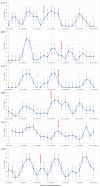The perfect storm: temporal analysis of air during the world's most deadly epidemic thunderstorm asthma (ETSA) event in Melbourne
- PMID: 37646293
- PMCID: PMC10469229
- DOI: 10.1177/17534666231186726
The perfect storm: temporal analysis of air during the world's most deadly epidemic thunderstorm asthma (ETSA) event in Melbourne
Abstract
Background: There have been 26 epidemic thunderstorm asthma (ETSA) events worldwide, with Melbourne at the epicentre of ETSA with 7 recorded events, and in 2016 experienced the deadliest ETSA event ever recorded. Health services and emergency departments were overwhelmed with thousands requiring medical care for acute asthma and 10 people died.
Objectives: This multidisciplinary study was conducted across various health and science departments with the aim of improving our collective understanding of the mechanism behind ETSA.
Design: This study involved time-resolved analysis of atmospheric sampling of the air for pollen and fungal spores, and intact and ruptured pollen compared with different weather parameters, pollution levels and clinical asthma presentations.
Methods: Time-resolved pollen and fungal spore data collected by Deakin AirWATCH Burwood, underwent 3-h analysis, to better reflect the 'before', 'during' and 'after' ETSA time points, on the days leading up to and following the Melbourne 2016 event. Linear correlations were conducted with atmospheric pollution data provided by the Environment Protection Authority (EPA) of Victoria, weather data sourced from Bureau of Meteorology (BOM) and clinical asthma presentation data from the Victorian Agency for Health Information (VAHI) of Department of Health.
Results: Counts of ruptured grass pollen grains increased 250% when the thunderstorm outflow reached Burwood. Increased PM10, high relative humidity, decreased temperature and low ozone concentrations observed in the storm outflow were correlated with increased levels of ruptured grass pollen. In particular, high ozone levels observed 6 h prior to this ETSA event may be a critical early indicator of impending ETSA event, since high ozone levels have been linked to increasing pollen allergen content and reducing pollen integrity, which may in turn contribute to enhanced pollen rupture.
Conclusion: The findings presented in this article highlight the importance of including ruptured pollen and time-resolved analysis to forecast ETSA events and thus save lives.
Keywords: allergic asthma; environmental health; epidemic thunderstorm asthma; grass pollen allergy; pollen rupture; public health; thunderstorm asthma.
Conflict of interest statement
The authors declared no potential conflicts of interest with respect to the research, authorship, and/or publication of this article.
Figures










References
-
- Thien F, Beggs PJ, Csutoros D, et al.. The Melbourne epidemic thunderstorm asthma event 2016: an investigation of environmental triggers, effect on health services, and patient risk factors. Lancet Planet Health 2018; 2: e255–e263. - PubMed
-
- Suphioglu C. Thunderstorm asthma due to grass pollen. Int Arch Allergy Immunol 1998; 116: 253–260. - PubMed
-
- Price D, Hughes KM, Thien F, et al.. Epidemic thunderstorm asthma: lessons learned from the storm down-under. J Aller Clin Immunol 2021; 9: 1510–1515. - PubMed
-
- Hew M, Lee J, Susanto NH, et al.. The 2016 Melbourne thunderstorm asthma epidemic: risk factors for severe attacks requiring hospital admission. Allergy 2019; 74: 122–130. - PubMed
-
- D’Amato G, Cecchi L, Liccardi G. Thunderstorm-related asthma: not only grass pollen and spores. J Allergy Clin Immunol 2008; 121: 537–538; author reply 538. - PubMed
MeSH terms
Substances
LinkOut - more resources
Full Text Sources
Medical
Research Materials

